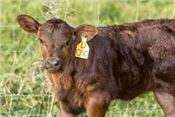Cattle Markets More Stable A Year Into COVID-19 Pandemic
LEXINGTON, KEN.
A year ago, cattle markets were swinging up and down amid the early months of the COVID-19 pandemic. This year, cattle markets are more stable, and the future looks promising.
“2021 looks a whole lot like the 2020 we expected had it not been for COVID-19,” said Kenny Burdine, agricultural economist for the University of Kentucky College of Agriculture, Food and Environment.
“The supply this year looks about the same as it did last year, maybe a little bit better. The calf crop will be a bit smaller, which usually helps support our fall markets.”
Burdine said one thing that is really helping is improved demand. When COVID-19 hit, most of the country shut down. Many restaurants closed or reduced sales without indoor dining, and the demand for beef went down. But now with fewer restrictions, warmer weather for outdoor dining and many people going back out, demand is up.
“I think everyone expects more of the constraints to be lifted as we move through this year,” Burdine said. “Demand should continue to improve throughout 2021.”
The first few months of 2021 were encouraging in terms of exports. The U.S. moved quite a bit of beef to other countries, with China particularly strong the first two months of 2021.
“The combination of improving demand, increased exports and just a more normal scenario overall points to a better 2021,” Burdine said.
“The fall feeder cattle board is trading at a big premium. That means the expectation is that prices are going to be a whole lot better as we get into summer and fall. So, a lot of our fall cow-calf operations that are now moving weaned calves are going to benefit from the fact that those calves could be placed in a grazing program and sold on a much stronger market this fall.”
The cattle industry has weathered the pandemic storm, but not without significant impacts on profitability for cattle producers across the system. Impacts were seen on cow-calf, stocker, backgrounding and finishing operations. Burdine said direct payments through the Coronavirus Food Assistance Program certainly helped, but they didn’t make up for what producers lost last year.
“There were losses last year that we’re not going to get back, but we are certainly set up for an improved 2021,” he said. “Our newest challenge is drastically higher feed prices, which are impacting costs for growing operations and the value of heavy feeder cattle being sold.” ∆

Photo by Steve Patton